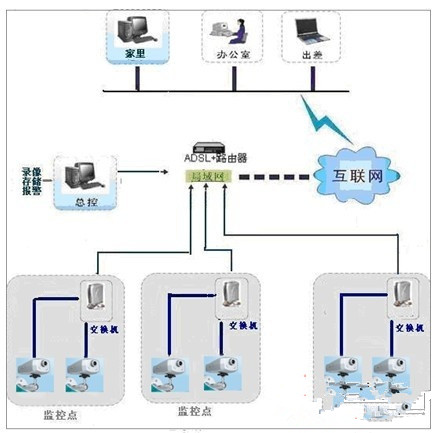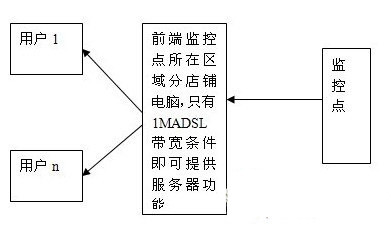In order to further improve the management of each chain store; establish a rapid response mechanism; improve the internal operation and management level of the enterprise, use advanced computer communication and image compression processing technology to realize the headquarters to each other based on the original monitoring equipment and network resources. Unified centralized monitoring of the job site. The system is a multi-purpose system with remote centralized monitoring and live broadcast.
This article refers to the address: http://
By digitizing and networking the monitoring front-end video signals, authorized users in the network can view clear live images anytime and anywhere through the network.
System design
Branches, direct sales and franchise stores that need to be monitored are distributed throughout the country, with scattered locations, a large number of users, and a large number of users viewing images. A large-scale network video project is a complex project that requires close coordination of various systems. First, it should focus on practicality, stability, manageability, maintainability, scalability, and integration.
Front-end monitoring design ideas
A) The front-end monitoring points are divided into convenience stores, direct-operated and franchised stores, and the front-end monitoring sites first consider network communication resources. The front-end network, especially the uplink rate, directly affects the video transmission effect. Direct-operated and franchised stores use telecom ADSL as the transmission. Link, ADSL is a low-cost broadband access method, but it is also an unstable broadband access method. It is affected by many factors such as telephone line, ADSL, modem, and distance from the access room. The telecom cooperates with the guaranteed upload rate. It is recommended that the uplink rate be applied to 512K-1Mbps to ensure efficient transmission of images.
B) Under normal circumstances, an ADSL line can only guarantee one or several channels of video transmission. Considering that some shops have a large area, and there are obstacles, dead angles, etc., two network cameras need to be installed. Through the router to access multiple cameras, and then through the work computer of each store for processing and forwarding, the frame rate is increased, the amount of data is reduced, and the server function can be provided. It not only monitors dead angles, but also makes full use of existing equipment to achieve high-end equipment with low-end cost.

Video Transmission System Architecture Selection Currently, network video transmission mainly has two different system structures: a central server and no central server.
A) The structure without a central server is relatively simple. Since the network camera has a plug-and-play function, you can enter the factory-configured dynamic domain name address in IE during access, or configure the client software for the first time. Yes, then connect to access the image. No user is required to apply for a domain name. Video data is transmitted directly from the network video server to the monitoring client. Such a system has a small number of monitoring channels, and is generally applicable in the case of a metropolitan area network access. The advantage is that the structure is simple and easy to understand. The disadvantage is that the transmission effect is not ideal, especially for cross-regional transmission, because the uploading rate of the monitoring point and the download speed of the client cannot be fully utilized; the management is difficult; the permission setting is single; the same image is not supported by multiple people at the same time; system integration difference.
B) Because the monitoring sites are distributed throughout the country, the number is large. In order to achieve good video transmission and easy management. Therefore, consider a video transmission structure combined with a distributed server group with a central server. Among them, the main function of video cross-region transmission and multi-person simultaneous access is the forwarding service module. Its video transmission link is shown below:

This structure makes full use of P2P technology and the existing network environment. The uploading speed of the front-end monitoring point is only 500K and the download speed of the client can also achieve good results. In the current practical application, when multiple people watch a point At this time, the monitoring point is not required to increase the bandwidth.
System management design
For cross-regional monitoring projects, the quality of management functions directly affects the long-term stable operation of the system. Management includes unified management of system equipment and unified management of authority.
A) Equipment management and maintenance is the main factor to maintain long-term stable operation of the system. For systems with dozens or more monitoring sites, it is unthinkable that there is no unified management mechanism. The system uses background SQL data support to achieve unified management of all devices and server modules, and the parameters of any device can be modified in the monitoring center. Different devices can be divided into different groups, which is intuitive and convenient, and is also beneficial to rights management. After all the devices need to be managed by the administrator, the authorized users can obtain the monitored monitoring points.
B) Rights management is also an important part. Uniform authorization for different users, stipulation of the camera that can be viewed and other operations can help the company keep the information confidential and keep the system running normally.
System failures are redundant with mechanisms and security mechanisms
This system provides fault redundancy mechanisms for various parts of the system.
After detailed understanding of the actual situation and needs, combined with the characteristics of large-scale network video transmission, after comprehensive consideration, it decided to adopt advanced networked monitoring system as the core component of the system.
The whole system is mainly composed of 5 parts: front-end monitoring point, transmission network, monitoring center, client
Front-end monitoring point
It refers to direct and affiliated stores. The main front-end equipment consists of network cameras and routers. Since the network camera itself integrates lenses, pickups, etc., it has few devices and is easy to install. For a store with a computer, the multi-channel video that needs to be monitored is simultaneously transmitted to the headquarters through computer forwarding.
monitoring Center
The initial monitoring center is mainly composed of a PC server located in the headquarters area. The computer server is equipped with Wanjiaan Industrial Super Client Software, which not only provides functions such as viewing monitoring screens, videos, alarms, but also provides P2P forwarding services. Many users view the data provided without increasing the burden on the front-end device.
Client
Authorized people can become a client through IE login, and perform operations within the authorization. The requirements for the client are required to have IE6.0 or higher browser DX8.0 or higher. The occupied bandwidth is the number of concurrent monitoring image channels multiplied by each channel. The bandwidth occupied by the image (specifically varies according to the settings), because of the P2P technology, there is no need to worry about the bandwidth of the monitoring front end or the server. When applying for bandwidth, you only need to consider the downlink bandwidth. It is recommended to apply for bandwidth to consider some bandwidth redundancy.
Led Street Lamp,Street Light,Led Garden Lights,Outdoor Garden Lights
ZHEJIANG TIANHONG LITHIUM-ION BATTERY CO.,LTD , https://www.tflbattery.com
